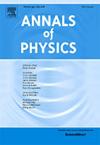Energy conditions and gravitational baryogenesis in f(R,R) gravity
IF 3
3区 物理与天体物理
Q2 PHYSICS, MULTIDISCIPLINARY
引用次数: 0
Abstract
In this work, first we examine the energy conditions in the context of the generalized metric-Palatini hybrid gravity, known as gravity. We show that for the proposed model in this study, i.e. , one of the four fundamental energy conditions, specifically the strong energy condition, does not hold for some values of . Therefore, it seems that hybrid gravity can provide a model for the accelerated expansion of the universe. In continuation of completing our study in this work, we try to analyze the impact of hybrid metric-Palatini gravity on the gravitational baryogenesis process. The hybrid metric-Palatini model combines two gravitational theories that allow for a more detailed examination of the behavior of space–time and its interaction with matter. This combination is critical in the early radiation-dominant universe, where unusual gravitational effects may play a key role in generating baryonic asymmetry and the production of baryons and anti-baryons.
f(R,R)重力下的能量条件和重力重子生成
在这项工作中,我们首先研究广义度量-帕拉蒂尼混合引力(称为f(R,R)引力)背景下的能量条件。我们证明,对于本研究提出的模型f(R,R)=R+αRn,四种基本能量条件之一,特别是强能量条件在某些n值下不成立。因此,混合引力似乎可以为宇宙的加速膨胀提供一个模型。为了继续完成本工作的研究,我们试图分析度量-帕拉蒂尼混合重力对重力重子发生过程的影响。混合度规-帕拉蒂尼模型结合了两种引力理论,可以更详细地研究时空的行为及其与物质的相互作用。这种组合在早期以辐射为主的宇宙中是至关重要的,在那里,不寻常的引力效应可能在产生重子不对称以及重子和反重子的产生中起着关键作用。
本文章由计算机程序翻译,如有差异,请以英文原文为准。
求助全文
约1分钟内获得全文
求助全文
来源期刊

Annals of Physics
物理-物理:综合
CiteScore
5.30
自引率
3.30%
发文量
211
审稿时长
47 days
期刊介绍:
Annals of Physics presents original work in all areas of basic theoretic physics research. Ideas are developed and fully explored, and thorough treatment is given to first principles and ultimate applications. Annals of Physics emphasizes clarity and intelligibility in the articles it publishes, thus making them as accessible as possible. Readers familiar with recent developments in the field are provided with sufficient detail and background to follow the arguments and understand their significance.
The Editors of the journal cover all fields of theoretical physics. Articles published in the journal are typically longer than 20 pages.
 求助内容:
求助内容: 应助结果提醒方式:
应助结果提醒方式:


